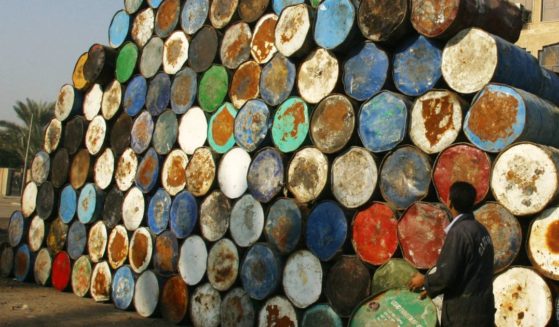National Park Service Takes Desperate Measure to Save Ancient Native Fish Hiding at the Bottom of the Grand Canyon
To guide fishing trips for a year or two, that’s what brought Terry Gunn to the red canyons of northern Arizona. The chance to hike, raft and fly fish drew Wendy Hanvold, a retired ski bum, who took a job there waiting tables at an anglers lodge. She heard rumors of the intrepid fishing guide who had just returned from an Alaska trip, and one day when he came in approached his table to take his order.
“You fly fish, right?” she said. “I’ve always wanted to learn.”
It was a match made in Marble Canyon.
Since then, the couple opened an anglers shop and guide service, purchased a lodge and raised their son. They take pride in showing tourists the best spots to catch and release prized rainbow trout beneath craggy cliffs carved by the Colorado River.
But it could all soon change as warmer water temperatures threaten fish survival — and the Gunn’s livelihood.
Key Colorado River reservoirs Lake Powell and Lake Mead are both only about one-quarter full. The continued drop, due to overuse and an increasingly arid climate, is threatening the fish and the economies built around them.
“We’re in totally uncharted territory,” Gunn said.
Since late August, the water temperature at Lees Ferry — the site of a world-famous trout fishery — has risen above 70 degrees seven times. That might be idyllic for a summer dip under the blazing Arizona summer sun, Gunn said, but it can mean peril for the beloved sport fish. A few degrees higher can be lethal.
To make matters worse, when temperatures rise, the amount of oxygen dissolved in the water falls, making it tough for fish to even breathe.
As the reservoir drops, it sends warmer water with less oxygen into the river below the dam. Should that water reach 73 degrees, Gunn said his family’s guide service could start calling off afternoon trips.
Recently, a small reprieve of cooler temperatures has taken the edge off the fear at Lees Ferry, but uncertainty still taints the air.
“Mother Nature holds a handful of trump cards, and if she decides to play one, there’s not a damn thing you can do about it,” Gunn said.
Seven states, Mexico and tribal nations depend on the stressed Colorado River. They have undergone voluntary and mandatory cuts and are grappling with how to further reduce their reliance on the river by about 15 to 30 percent, per a recent mandate by the Department of the Interior.
Struggling aquatic life further complicates the already delicate river management and increases the cost.
Just a few miles north of Lees Ferry and its trout fishery there’s another threat — nonnative predatory smallmouth bass. They’re supposed to be contained in Lake Powell. But this summer they were found in the river below the dam. Smallmouth bass already wreaked havoc on native fish way upriver where the government spends millions of dollars each year to control the predators. They were held at bay in Lake Powell because Glen Canyon Dam has served as a barrier for them for years — until now. The reservoir’s recent sharp decline is enabling these fish to shoot through the dam and edge closer to the Grand Canyon, where the biggest groups of humpback chub, an ancient, threatened, native fish, remain.
On Saturday, the National Park Service went so far as to apply chemicals to kill these predatory fish. The infested area is sealed off from the river with a vinyl barrier, desirable fish are moved to the main channel, and the substance is applied to just that area, National Park Service fisheries biologist Jeff Arnold said. A second treatment is likely later this fall. The Bureau of Reclamation has said it will contribute $30,000 for the second treatment and is exploring additional funding from the Bipartisan Infrastructure Law and Inflation Reduction Act for longer-term solutions, such as barriers that would prevent fish from even approaching the dam.
A mid-term solution could involve a technique that lets cold water from deeper in the lake flow into the river below. Although this would mean forgoing hydropower, the cool water would disrupt spawning of predatory fish. It’s been successful in other rivers and could help protect both native fish and rainbow trout.
Several hundred miles downstream, at the site of another fish threat, one hatchery has completely shut down. Lake Mead Fish Hatchery, which used to breed endangered razorback sucker and bonytail chub, ceased operations earlier this year when the lake dipped below the point where the hatchery drew its water.
Last month, the state of Nevada and the Bureau of Reclamation announced they’re kicking in nearly $12 million on a project to pull water from deeper in the lake into the hatchery. The new line will source water from a third straw that the Southern Nevada Water Authority built following a severe drop in lake levels in the early 2000s. As Lake Mead plummeted this year, the agency had to begin using it to rescue Las Vegas, and soon, the hatchery.
Walking into a silent hatchery, normally abuzz with flowing water and air compressors, is a challenge, Nevada Department of Wildlife supervising fish biologist Brandon Singer said.
“At first you feel kind of lost, your purpose is gone,” Singer said. But it’s been an opportunity for repair work and for his team to work on species in other parts of the state while they await their return to fish-rearing.
Maintaining native fish populations is a legal obligation the bureau has under the Endangered Species Act. It could face a lawsuit if it fails to meet that obligation, even as it juggles other pressing demands on the river.
Back upstream near Lake Powell, the introduced rainbow trout don’t have the same protection. Losing them would be heartbreaking but feels inevitable, said Gunn, who checks water temperature religiously. “It’s like watching a family member grow old or die — it’s gonna happen.”
Wendy Gunn says if the trout fishery is lost and smallmouth bass take over, she could imagine Lees Ferry transitioning to a haven for warm water fish. It would be tragic in many ways, with the beloved rainbow trout gone and the likelihood that native fish downstream could be next, she said, but people would still come to cast lines.
“Everybody’s just gonna have to adapt,” Wendy said. “You either roll with it and change, or you go away.”
The Western Journal has reviewed this Associated Press story and may have altered it prior to publication to ensure that it meets our editorial standards.
Truth and Accuracy
We are committed to truth and accuracy in all of our journalism. Read our editorial standards.












